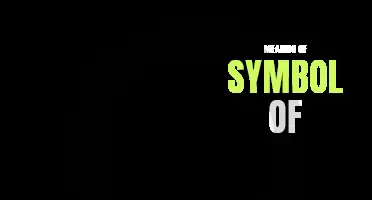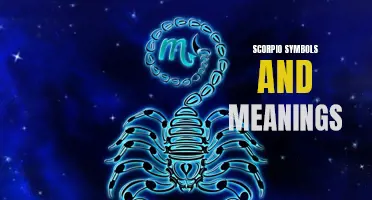
Henna hand symbols have been an important cultural representation for centuries, captivating people with their intricate designs and deeper meanings. Originating in ancient Egypt and spreading throughout the Middle East, North Africa, and South Asia, henna hand symbols hold a wealth of symbolism and reflect various aspects of life, spirituality, and cultural beliefs. From protection against evil spirits to celebrating marriage and fertility, the henna hand symbol meaning is as fascinating as the art itself. Let's delve deeper into the diverse interpretations and symbolism behind these captivating designs.
What You'll Learn
- What is the cultural significance of the henna hand symbol?
- How does the meaning of the henna hand symbol vary in different cultures?
- What are the different symbols and patterns often found in henna hand designs?
- What does it mean when someone gets a henna hand symbol as a tattoo?
- How has the meaning and symbolism of the henna hand symbol evolved over time?

What is the cultural significance of the henna hand symbol?
The henna hand symbol, also known as mehndi, holds considerable cultural significance in many parts of the world, particularly in South Asia, North Africa, and the Middle East. The practice of applying henna to the skin dates back thousands of years and is deeply rooted in tradition and symbolism.
In these regions, henna is often used to adorn the hands and feet of brides as part of wedding celebrations. It is believed to bring blessings, luck, and protection to the bride on her journey into married life. The intricate patterns and designs symbolize beauty, fertility, and the power of the divine feminine.
The henna hand symbol is not limited to wedding ceremonies alone. It is also a popular form of body art and decoration for festive occasions such as Eid, Diwali, and other cultural celebrations. The application of henna is seen as a way to enhance natural beauty and express creativity.
In addition to its aesthetic appeal, henna also carries spiritual and medicinal properties. It is believed to have cooling effects on the body and can provide relief from certain ailments. The natural dye used in henna, Lawsonia inermis, is known for its antimicrobial and antifungal properties, suggesting that henna may have been used historically as a form of protection against bacterial and fungal infections.
The henna hand symbol is not only significant in the cultural traditions of these regions but has also gained popularity worldwide. Many people in Western countries have embraced henna as a temporary form of body art, often getting henna tattoos during music festivals, weddings, and other special events.
However, it is essential to understand and respect the cultural significance of the henna hand symbol when adopting it as a trendy fashion statement. For the communities that practice henna as part of their cultural heritage, it holds deep-rooted meaning and symbolism, and it is essential to approach it with appreciation and understanding.
In conclusion, the cultural significance of the henna hand symbol is rich and varied. It represents beauty, fertility, protection, and the power of the divine feminine. It is an integral part of wedding ceremonies and cultural celebrations in South Asia, North Africa, and the Middle East. Additionally, it carries spiritual and medicinal properties, making it a multifaceted art form. When embracing henna as a fashion statement, it is vital to respect its origins and appreciate its cultural meaning.
The Hidden Meaning and Symbolism Behind Balloons: Exploring Their Significance
You may want to see also

How does the meaning of the henna hand symbol vary in different cultures?
The henna hand symbol is a cultural tradition that has been embraced by different cultures around the world. It is a symbol of creativity, beauty, and celebration, but its meaning can vary significantly in different cultures.
In Indian culture, the henna hand symbol is known as mehndi. It is an ancient art form that dates back over 5,000 years. In Indian weddings, the bride's hands and feet are adorned with intricate henna designs that symbolize love, prosperity, and fertility. The henna hand symbol is also seen as a way to ward off evil spirits and bring good luck to the newlywed couple. In this context, the henna hand symbol represents joy, happiness, and a new beginning.
In Arab culture, the henna hand symbol is called henna. It is often used for celebrations such as weddings, Eid, and other special occasions. The henna designs are known for their geometric patterns and floral motifs. In Arab culture, the henna hand symbol is seen as a form of self-expression and adornment. It is also believed to bring good fortune and protection from evil spirits. The henna hand symbol in Arab culture is a way to celebrate beauty, femininity, and tradition.
In African culture, the henna hand symbol is known as laali. It is commonly used by women to adorn their hands and feet for special occasions such as weddings, naming ceremonies, and festivals. The henna designs in African culture are often bold and intricate, incorporating symbols and patterns that hold cultural significance. The henna hand symbol in African culture is a way to celebrate identity, heritage, and community. It is also seen as a form of protection and a means to honor ancestors.
In Western culture, the henna hand symbol has gained popularity as a form of temporary body art. It is often seen at events such as music festivals, parties, and even as a fashion statement. In this context, the henna hand symbol is more about personal expression and aesthetics rather than cultural or symbolic meaning. However, some individuals may still choose to incorporate meaningful symbols or designs into their henna art to reflect their own beliefs or identity.
Overall, the meaning of the henna hand symbol can vary in different cultures. It can symbolize love, prosperity, and fertility in Indian culture, self-expression and tradition in Arab culture, identity and heritage in African culture, and personal expression in Western culture. Regardless of its cultural significance, the henna hand symbol remains a beautiful and intricate art form that continues to be celebrated and embraced by people around the world.
Unlocking the Hidden Meaning of the Jewish Chai Symbol
You may want to see also

What are the different symbols and patterns often found in henna hand designs?
Henna hand designs have been used for centuries as a form of body art and cultural expression. The intricate patterns and symbols found in henna designs vary by region and can have different meanings depending on the culture.
One of the most common symbols found in henna hand designs is the peacock. In many cultures, the peacock is a symbol of beauty and grace. It is often depicted with its feathers spread out, showcasing its vibrant colors. The peacock is typically incorporated into the design as a centerpiece or as a repeated motif throughout the hand.
Another popular symbol found in henna hand designs is the lotus flower. The lotus is a sacred flower in many Eastern cultures and symbolizes purity, enlightenment, and rebirth. It is often depicted with its petals unfolding and is believed to represent the journey of spiritual growth and self-realization.
Vine and leaf motifs are also commonly seen in henna hand designs. These designs often start at the fingers or wrist and extend up the arm, creating a trailing, organic pattern. The vine symbolizes growth, fertility, and connection to nature, while the leaves represent abundance and vitality.
In addition to these symbols, henna hand designs often incorporate geometric patterns. These patterns can include intricate latticework, geometric shapes, and repeated motifs. Geometric patterns represent order, balance, and harmony in many cultures. They can also symbolize spirituality and the interconnectedness of all things.
Symbols of love and protection, such as hearts and eyes, are also frequently found in henna hand designs. These symbols are believed to bring love, good fortune, and protection against evil energies or spirits. Hearts can represent love, compassion, and emotional well-being, while eyes symbolize insight, awareness, and protection.
Finally, henna hand designs often feature abstract patterns and shapes. These designs can be created using dots, lines, and swirls, and they often fill in the spaces between the larger symbols and motifs. Abstract patterns symbolize creativity, individuality, and the infinite possibilities of the universe.
In conclusion, the symbols and patterns found in henna hand designs are rich in cultural significance and symbolism. From the peacock and lotus flower to vine and leaf motifs, geometric patterns, symbols of love and protection, and abstract designs, henna hand designs are a beautiful form of self-expression that carry deep meaning across various cultures.
The Symbolic Meaning Behind the Pleiades: Unraveling the Mysteries of this Celestial Cluster
You may want to see also

What does it mean when someone gets a henna hand symbol as a tattoo?
Henna is a natural dye that is extracted from the leaves of the henna plant. It has been used for centuries in various cultures for body art and hair coloring. One of the most popular forms of henna body art is the henna hand symbol, also known as mehndi.
Getting a henna hand symbol as a tattoo has deep cultural significance. In many Middle Eastern and South Asian cultures, henna is considered a symbol of beauty, purity, and auspiciousness. It is often used to celebrate special occasions like weddings, festivals, and religious ceremonies.
The henna hand symbol is created by applying henna paste on the hands in intricate designs. These designs can vary from simple geometric patterns to elaborate motifs of flowers, birds, and other symbols. The paste is left on the skin for several hours to dry and stain the skin.
When someone gets a henna hand symbol as a tattoo, they are embracing the cultural tradition and expressing their connection to the culture. It is a way of appreciating the beauty and artistry of henna designs. Additionally, getting a henna hand symbol as a tattoo can also be a form of self-expression and personal style.
The meaning of a henna hand symbol can vary depending on the specific design and cultural context. In some cultures, certain symbols and motifs may have specific meanings. For example, a peacock design may symbolize beauty and grace, while a lotus flower design may represent purity and enlightenment.
In general, however, the henna hand symbol is often associated with good luck, protection, and blessings. It is believed to ward off evil spirits and bring positive energy to the wearer. The intricate patterns and designs are also thought to have a calming and meditative effect on the mind and body.
While henna tattoos are not permanent like traditional tattoos, they can last for several weeks. The natural dye gradually fades away as the layers of skin exfoliate. This temporary nature of henna tattoos adds to their appeal, as they can be changed or refreshed with new designs.
In recent years, henna hand symbols have gained popularity in Western countries as a form of body art. Many people appreciate the intricate designs and cultural significance of henna tattoos, even if they do not have any personal or cultural connection to them.
In conclusion, getting a henna hand symbol as a tattoo is a way of embracing the cultural tradition and expressing personal style. It can symbolize beauty, auspiciousness, and protection, while also serving as a temporary form of body art. Whether you choose to get a henna hand symbol for its cultural significance or simply for its aesthetic appeal, it is a unique and meaningful choice.
The Fascinating World of Choctaw Symbols and Meanings: Unveiling the Rich Cultural Heritage
You may want to see also

How has the meaning and symbolism of the henna hand symbol evolved over time?
The henna hand symbol has a rich and long history, and its meaning and symbolism has evolved significantly over time. Henna, also known as mehndi, is a natural dye made from the leaves of the henna plant. The dye is used to create intricate designs on the skin, particularly on the hands and feet, and has been a part of various cultural and religious traditions for centuries.
In ancient times, henna was used as a form of body art and decoration. It was believed to have a cooling effect on the body and was used during hot seasons to protect against the sun's rays. Henna was also associated with fertility and used in wedding ceremonies to bless the couple with good luck and prosperity.
Over time, the henna hand symbol became associated with specific meanings and purposes within different cultures. In Middle Eastern and North African cultures, the henna hand symbol became a form of self-expression. Women would adorn their hands with intricate designs during festive occasions such as weddings and religious celebrations. These designs were seen as a way to enhance beauty and showcase cultural identity.
In South Asian cultures, the henna hand symbol has deep religious significance and is commonly used during weddings and religious festivals. The designs often include intricate patterns and symbols that carry specific meanings. For example, peacock feathers symbolize beauty and grace, while paisley patterns represent fertility and growth. The henna hand symbol in South Asian cultures is believed to bring good luck and protection against evil spirits.
In recent years, the henna hand symbol has gained popularity outside of traditional cultural contexts. It has become a fashionable accessory and a form of body art for individuals of various backgrounds. Henna is often used as a temporary tattoo, with designs ranging from traditional patterns to modern interpretations. It is not uncommon to see henna hand symbols at music festivals, parties, and other events.
However, this evolving trend has also sparked controversy and discussions about cultural appropriation. Some argue that the commercialization of henna and its detachment from its cultural roots is disrespectful and diminishes its significance. It is important to respect and understand the cultural origins of the henna hand symbol while appreciating its beauty and aesthetics.
In conclusion, the meaning and symbolism of the henna hand symbol have evolved over time. From its ancient use as a decorative body art to its significance in various cultural and religious traditions, the henna hand symbol carries deep meanings and serves different purposes. While it has become a popular trend in recent years, it is important to recognize and respect its cultural origins. The henna hand symbol remains a powerful and beautiful form of self-expression and celebration of cultural identity.
Decoding the Hidden Meanings Behind Branding Symbols
You may want to see also
Frequently asked questions
The henna hand symbol, also known as mehndi, is a traditional form of body art that originated in ancient cultures. It is often applied to the hands and feet using a paste made from the henna plant. The symbol holds different meanings across different cultures, but it is commonly associated with blessings, protection, and fertility. It is also seen as a form of self-expression and beauty.
The patterns in the henna hand symbol are highly detailed and intricate. Each pattern holds its own significance and meaning. For example, floral patterns represent beauty and happiness, while geometric patterns symbolize order and balance. The patterns can also be personalized to reflect the individual's desires and beliefs.
Yes, the henna hand symbol holds significant cultural and religious associations. In many Middle Eastern and South Asian cultures, henna is traditionally applied during weddings, festivals, and other joyous occasions. It is seen as a symbol of good luck, protection from evil spirits, and a way to bring blessings and prosperity to the individual. In some religious rituals, henna is also used as a form of purification and cleansing.
While henna is often associated with women, men can also wear the henna hand symbol. However, the designs and patterns for men are usually different than those for women. Men typically opt for simpler and more geometric designs, while women often prefer more intricate and delicate patterns. Ultimately, henna is a form of self-expression and can be worn by anyone who appreciates its beauty and symbolism.
The longevity of the henna hand symbol depends on various factors, such as the quality of the henna paste, how well it is applied, and how often the hands are washed. Typically, henna designs can last anywhere from one to three weeks. The color of the henna will darken over the first 24 to 48 hours and then gradually fade away. To prolong the life of the henna design, it is advised to avoid excessive washing or scrubbing of the hands.



















